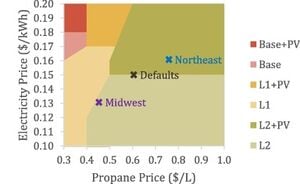Decarbonizing rural residential buildings in cold climates: A techno-economic analysis of heating electrification

Given the need for decarbonization of the heating sector and the acute need of a propane replacement in the U.S. Upper Midwest, this study quantifies the techno-economic characteristics of sustainable heating electrification in isolated rural, residential buildings in cold climates without natural gas supply. Archetypal buildings are modeled under four levels of electrification. At each electrification level, a parametric solar photovoltaic (PV) sizing analysis is performed and the total life cycle cost, renewable fraction and greenhouse gas (GHG) emissions are calculated based on the primary energy supply for each building type. Cost optimal solutions are stress-tested with multi-dimensional sensitivity analyses. The results show that the total life cycle cost favors heating electrification in all cases and combining PV with heat pumps can reduce residential building GHG emissions by up to 50% immediately. This effect will grow over time, with over 90% reduction of building emissions if renewable energy targets are met. In using primary energy and emissions along with the multi-dimensional sensitivities, this study unique demonstrates the complex techno-economic interactions of PV and heat pumps. It is concluded that electrification is an economically viable decarbonization method for cold climates both now and in the future.
- Methods coming
Highlights[edit | edit source]
- Cost-optimal solar heat pumps are modeled for multiple residential buildings.
- Heating electrification reduces cost by up to 20% and GHG emissions by 30%
- Solar PV has a small impact on life cycle cost but doubles CO2 emission reductions.
- Sensitives show the complex economic relationship between PV and heat pumps.
&Electrification subsidies are not necessary but policies must support the transition.
Keywords[edit | edit source]
Photovoltaic,energy, solar energy, solar power, photovoltaics, Electrification, Heat pump, Solar heat pump, Decarbonization, Electrify everything
See also[edit | edit source]
- Economics of Grid-Tied Solar Photovoltaic Systems Coupled to Heat Pumps: The Case of Northern Climates of the U.S. and Canada
- Can grid-tied solar photovoltaics lead to residential heating electrification? A techno-economic case study in the midwestern U.S.
- Emerging economic viability of grid defection in a northern climate using solar hybrid systems
- Levelized cost of electricity for solar photovoltaic, battery and cogen hybrid systems
- Performance of U.S. hybrid distributed energy systems: Solar photovoltaic, battery and combined heat and power
- The Potential for Grid Defection of Small and Medium Sized Enterprises Using Solar Photovoltaic, Battery and Generator Hybrid Systems
- Review of solar levelized cost
- Simulations of Greenhouse Gas Emission Reductions from Low-Cost Hybrid Solar Photovoltaic and Cogeneration Systems for New Communities
- Policies to Overcome Barriers for Renewable Energy Distributed Generation: A Case Study of Utility Structure and Regulatory Regimes in Michigan
- A review of the value of solar methodology with a case study of the U.S. VOS
- Examining interconnection and net metering policy for distributed generation in the United States
- Energy Policy for Energy Sovereignty: Can policy tools enhance energy sovereignty?
- Achieving 100% Renewable and Self-Sufficient Electricity in Impoverished, Rural, Northern Climates: Case Studies from Upper Michigan, USA
- A Free and open-source microgrid optimization tool: SAMA the Solar Alone Multi-Objective Advisor
- Techno-Economic Evaluation of Electricity Pricing Structures on Photovoltaic and Photovoltaic-Battery Hybrid Systems in Canada
In the News[edit | edit source]
- Solar
- Papers
- SDG07 Affordable and clean energy
- SDG08 Decent work and economic growth
- SDG09 Industry innovation and infrastructure
- SDG11 Sustainable cities and communities
- SDG12 Responsible consumption and production
- 2021
- Energy
- Solar energy
- Solar power
- Photovoltaics
- Heat pumps
- Sustainable development
- Mechanical engineering




